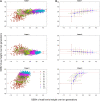Multi-trait Genomic Selection Methods for Crop Improvement
- PMID: 32482640
- PMCID: PMC7404246
- DOI: 10.1534/genetics.120.303305
Multi-trait Genomic Selection Methods for Crop Improvement
Abstract
Plant breeders make selection decisions based on multiple traits, such as yield, plant height, flowering time, and disease resistance. A commonly used approach in multi-trait genomic selection is index selection, which assigns weights to different traits relative to their economic importance. However, classical index selection only optimizes genetic gain in the next generation, requires some experimentation to find weights that lead to desired outcomes, and has difficulty optimizing nonlinear breeding objectives. Multi-objective optimization has also been used to identify the Pareto frontier of selection decisions, which represents different trade-offs across multiple traits. We propose a new approach, which maximizes certain traits while keeping others within desirable ranges. Optimal selection decisions are made using a new version of the look-ahead selection (LAS) algorithm, which was recently proposed for single-trait genomic selection, and achieved superior performance with respect to other state-of-the-art selection methods. To demonstrate the effectiveness of the new method, a case study is developed using a realistic data set where our method is compared with conventional index selection. Results suggest that the multi-trait LAS is more effective at balancing multiple traits compared with index selection.
Keywords: Genomic Prediction; multi-trait genomic selection; optimization; simulation.
Copyright © 2020 by the Genetics Society of America.
Figures










References
-
- Bates D., Mächler M., Bolker B., and Walker S., 2015. Fitting linear mixed-effects models using lme4. J. Stat. Softw. 67: 1–48. 10.18637/jss.v067.i01 - DOI
-
- Brascamp E., 1984. Selection indices with constraints. Anim. Breed. Abst. 52: 645–654.
Publication types
MeSH terms
LinkOut - more resources
Full Text Sources
Other Literature Sources

